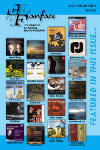Texte paru dans: / Appeared in:

Fanfare Magazine: 36:6 (07-08/2013)
Pour
s'abonner / Subscription information
Les abonnés à Fanfare Magazine ont accès aux archives du
magazine sur internet.
Subscribers to Fanfare Magazine have access to the archives of the magazine
on the net.
Harmonia Mundi
HMU907591.92

0093046759124 (ID289)
Consultez toutes les évaluations recensées pour ce cd
~~~~ Reach all the evaluations located for this CD
In about 1725 Johann Sebastian Bach put together these six suites that his biographer Johann Nikolas Forkel alleged were “composed for an English nobleman.” Of course, there is no substantiation whatsoever for this assertion, and the title seems to have found all sorts of other explanations, none of which apparently come from Bach himself. In any case, there is nothing intrinsically “English” about them; rather, they form a nice cycle of keyboard suites in the ordinary French style of the period. They are at once genteel and complex works, with all of the intricacy that one might expect from Bach, but whether they were written as pedagogical works or as part of a sequence meant for entertainment in the home is not immediately apparent.
These works have been often recorded as they are firmly implanted in the keyboard repertoire. Christopher Brodersen noted a fine performance on Caro Mitis by Olga Martynova (Fanfare 34:5) which I purchased on his recommendation due to the nicely resonant sound of the playing. I am pleased to note that this recording by Richard Egarr, using a Ruckers copy at A=409Hz and with his own temperament, is every bit its equal in performance, though I find the sound considerably more transparent. The instrument is resonant where needed, but the lightness of texture often allows Bach’s inner parts to emerge from beneath the nicely phrased melodic lines. Egarr does a wonderful job at letting the music evolve, rather than playing entirely in a mechanical fashion. This is the way Bach should be done, with subtle nuances emerging from the texture in the slower dances, and, as in the Bourée of the Suite in A Major, the perpetual motion of the lines given a nice energy when phrased this way. This marks this set as particularly fine. If you haven’t yet purchased your recording of the English Suites, this is one that I believe will set a standard of excellence. For me, it has already replaced the Martynova as my favorite.
Cliquez l'un ou l'autre
bouton pour découvrir bien d'autres critiques de CD
Click either button for many other reviews


